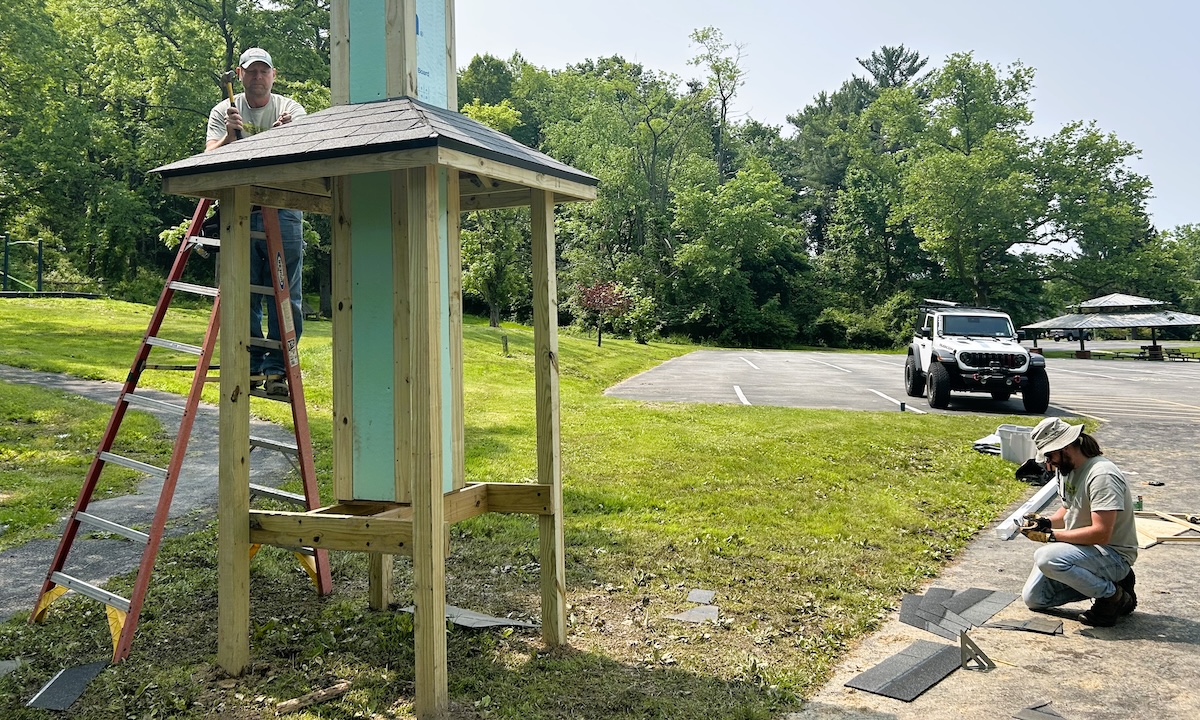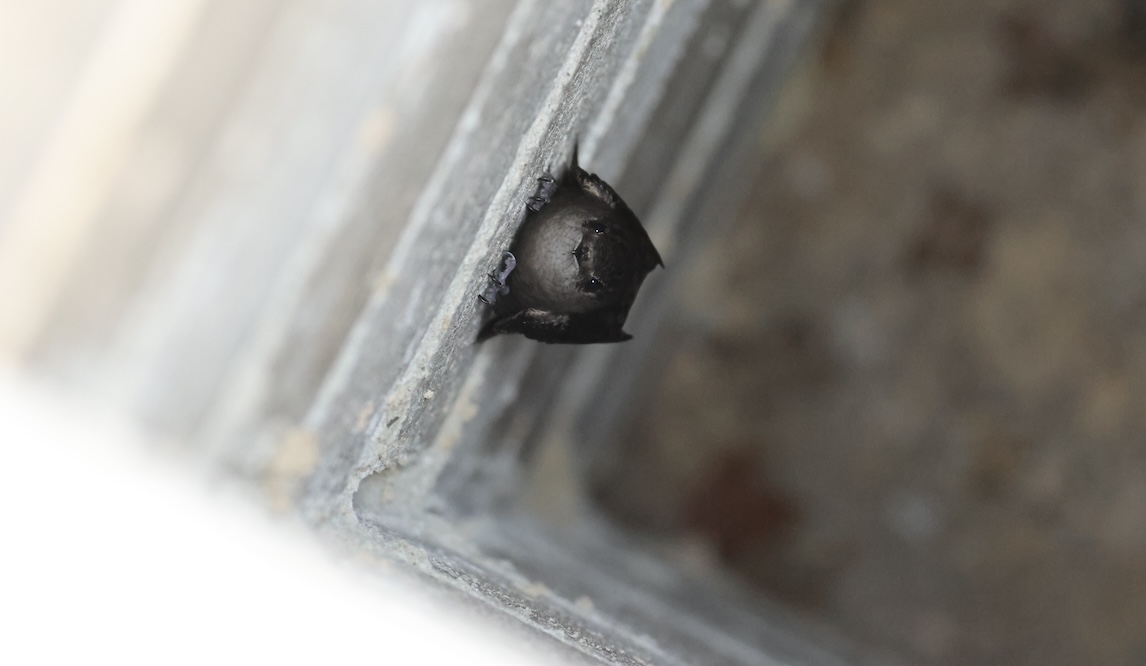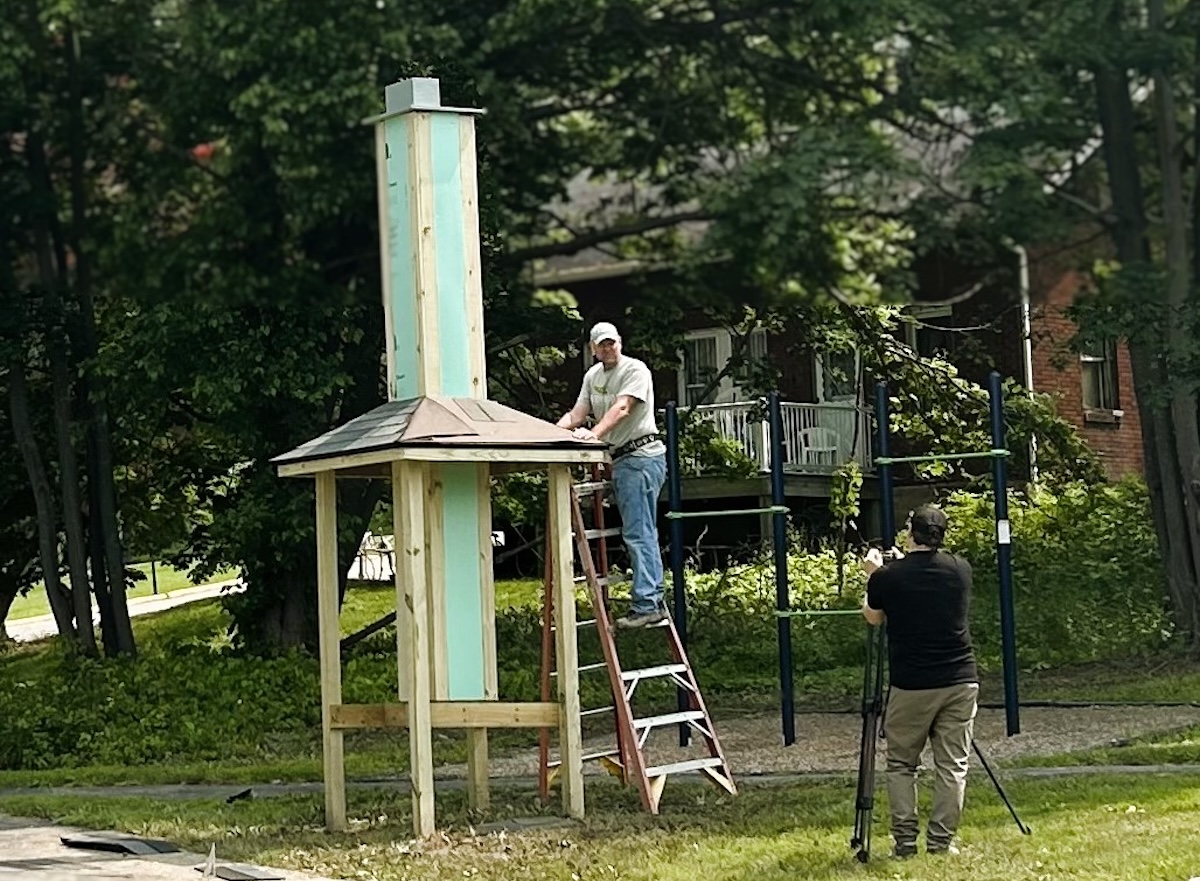(Advertisement)
Tube City Community Media Inc. is seeking freelance writers to help cover city council, news and feature stories in McKeesport, Duquesne, White Oak and the neighboring communities. High school and college students seeking work experience are encouraged to apply; we are willing to work with students who need credit toward class assignments. Please send cover letter, resume, two writing samples and the name of a reference (an employer, supervisor, teacher, etc. -- not a relative) to tubecitytiger@gmail.com.
Ads start at $1 per day, minimum seven days.
Renzie’s New Addition Has a Bird’s Eye View
Audubon Society hopes to lure chimney swifts, threatened for more than a decade
By Leslie Savisky
The Tube City Almanac
June 09, 2025
Posted in: McKeesport and Region News

ASWP's Brian Shema (left) and Dan Mendenhall work to construct a nesting tower at Renzie Park. (Leslie Savisky photo for Tube City Almanac)
Exciting things are happening for bird lovers at Renziehausen Park as the Audubon Society of Western Pennsylvania builds a nesting tower for mating chimney swifts.
Native to the eastern United States, the birds can be recognized by their long, slender wings and very short legs. They feed on insects and, as their name implies, often roost in vertical structures, such as chimneys. The birds have been considered in decline since 2010 because they have been losing their habitats.
“They are not endangered,” said Brian Shema, operations director for ASWP. “The population is decreasing annually, though, which is why we want to keep these birds common.”
This decline is due in part to the loss of natural habitats and upgrades to chimneys — both of which lead to a lack of nesting sites.
According to ASWP Facility Steward Dan Mendenhall, chimney swifts live in every state east of the Rocky Mountains and in some parts of Southern Canada, while others like, black swifts and Vaux’s swifts, are more common on the other side of the country.
“They have very simple feet and can’t perch,” Mendenhall said of the gray insect-eaters. “Basically they have to cling or hang onto things.”

Above: Chimney swifts are a member of the genus Chaetura. They are small, grayish birds. Chimney swifts mainly feast on a diet of insects and can eat up to 12,000 insects daily. Below: A chimney swift roosts in one of the ASWP's concrete chimneys. (Both photos courtesy of Dan Mendenhall)

Since chimney swifts can’t perch on branches, they will hang on tree bark and use the insides of trees to build nests as well as human-made structures like vents, barns and chimneys. Which is what makes the nesting towers — or fabricated chimneys — so important.
According to Shema, ASWP has created 100 chimneys in Allegheny County parks — all thanks to a single grant. In Western Pennsylvania, there are now a total of 180 roosting chimneys, many of which were built using grant money.
The one being constructed by Shema and Mendenhall at Renzie Park is a 16-foot ground-based structure. Some chimneys are prefabricated in a shop, while some – like this nesting site – is built on site.
If utilized by these small, social birds, just a single pair of swifts will use the nesting tower, and they will return each year.
“The swifts use a stick and spit method,” Mendenhall said. “They make a crescent-shaped nest inside. And inside the chimney are grooves so they can hang.”
Although only one pair of nesting birds will use the chimney, it won’t go unused all winter. “When there’s a migration in the spring and fall, you’ll see overnight birds roosting there in major quantities,” Tom Rosso, McKeesport city electrician, said. “This [nesting tower] is the first one in Renzie Park, but hopefully not the last.”
The ASWP has the largest collection of nesting towers in North America; and towers are not as successful in other parts of the country or in Canada.

Dave Rohm (right), owner of the Pittsburgh-based production company "Wild Excellence Films" films a "how to" video on the construction of nesting towers, while ASWP's Brian Shema works. (Leslie Savisky photo for Tube City Almanac)
All told, only 60 to 65 percent of makeshift chimney are successful, meaning the birds are utilizing them for mating and nesting. With the support of the National Fish and Wildlife Foundation, the ASWP is currently conducting field research to determine what variables the swifts use when they are nesting.
“Our data collection is happening this year,” Shema said. Sometime in 2026, the ASWP plans to publish their findings.
According to the mayor’s office, the Audubon Society has been working with the City of McKeesport and the McKeesport Regional History & Heritage Center to increase nature-based programming and education in the region.
“Renzie Park is a recreational hub for McKeesport and surrounding communities. Thanks to the Audubon Society, we have been able to increase nature-based opportunities with monthly bird-watching walks, nature hikes and educational activities,” McKeesport Mayor Michael Cherepko said.
“This chimney swift tower is a wonderful addition to the park, and it sits near the entrance to a future nature trail that is currently in the planning stages.”
“The installation of a chimney swift tower is the final piece of a multi-phase project that the Heritage Center joined the Audubon Society in bringing to Renzie Park,” added McKeesport Regional History & Heritage Center President Jennifer Vertullo. “In 2024, we cleared invasive species from our landscaping to make way for native plants. Now, we hope the local birds will make use of those plants and take shelter in this new tower.”
Leslie Savisky is freelance writer and award-winning author from Penn Township. She is also the author of three fictional novels. Find out more at https://linktr.ee/lesliesavisky
Originally published June 09, 2025.
In other news:
"Students Appeal for C…" || "Penn State Offers Foo…"
 TM
TM